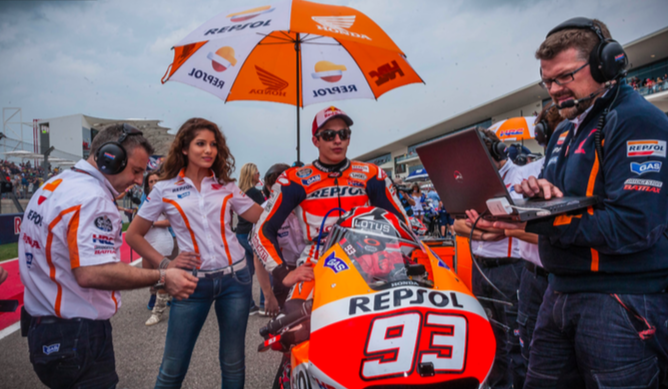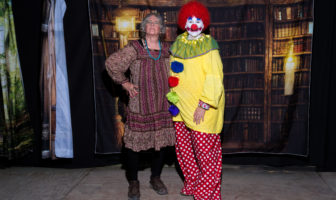MotoGP showcases the world’s top motorcycle racers and a whole lot of speed and corners.
By Steve Habel


MotoGP is the premier motorcycle racing championship in the world, essentially the Formula 1 of motorcycle racing. One of the series’ top events, the Red Bull Grand Prix of the Americas, returns to Austin April 10 through 12 at the Circuit of the Americas.
Twenty-five full-time riders from 11 countries, including Spain, Italy, Germany, Venezuela, Great Britain, Australia and the United States, line a grid armed with cutting-edge, two-wheeled technology and prototype machinery fielded by three motorcycle manufacturers: Ducati, Yamaha and Honda.
MotoGP events are conducted in 14 countries and on four continents with pan-global television coverage. Fans from throughout the world will converge in Central Texas for the three-day party of speed and merriment.
The sport features purpose-built, purebred racing motorcycles that are not street legal. They have a straight-line speed of more than 210 miles per hour. Like Formula 1, the series races solely on road courses and generally doesn’t stop because of rain. Races last about 20 laps, or about an hour.
Austin is the series’ second race of the 2015 racing season (after the Grand Prix of Qatar March 27 through 29) and is one of 18 races on the schedule. The only other in the United States is at Indianapolis Motor Speedway in August.
“In just three years, the MotoGP Red Bull Grand Prix of the Americas has become a favorite among riders, teams and fans,” says Dominic Iacono, the Circuit of the Americas’ chief marketing officer.
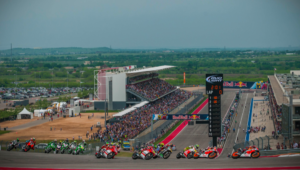

Perhaps the most striking feature of MotoGP is how much the riders lean into turns. During a turn, the rid- ers are on the edge of their tires, with their knees and elbows nearly touching the track surface, and usually in extremely tight quarters.
Spain’s Marc Márquez, the two-time defending champion of MotoGP and the winner of the Austin race in 2014, says the COTA circuit layout is clearly divided into two sections.
“The first part, where the chicanes are, is where the biggest difference can be made,” Márquez says. “Physically, this half of the track wears you out be- cause you’re constantly exerting yourself. It’s a track where there are a lot of spots for overtaking, which is great for the spectators. The final sector is fairly tricky too, above all, the three consecutive right- handed turns in turns 16, 17 and 18. There’s a lot of time to be won or lost there too.”
On a Grand Prix weekend, there is a race in each of MotoGP’s three categories: Moto3 (for 4-stroke, 250cc, single-cylinder-engine motorcycles), Moto2 (with bikes with 600cc, 4-stroke engines producing about 140 horsepower) and, ultimately, MotoGP, a test for the finest talents in motorcycle racing, in which the maximum engine capacity is the 1,000cc.
A Grand Prix event takes place during three days, with the first two of those for practice and qualification for each class, and the third solely for racing.
Márquez is a Dominating Champion
The 21-year-old Márquez dominated the sport last year, winning a premier-class record 13 races during the 2014 season, including the first 10. He won a second successive MotoGP championship, finishing 67 points clear of his nearest rival, Valentino Rossi of Italy.
Márquez currently rides for the Repsol Honda team, and Honda is the series’ reigning construc- tion champion.
Fun Off the Track
MotoGP has raced at the Circuit of the Americas every year since 2013. The crowds are generally motorcycle racing fans or motorcycle enthusiasts, but there are also many families and curious spectators. If you put the whole experience into just one word, that word would have to be “fun.”
New at the 2015 race, fans will be able to look over a comprehensive collection of memorabilia from stunt motorcycle legend Evel Knievel. The collection, which had been scattered throughout the world for years, will include Knievel’s motorcycles, helmets and riding leath- ers, never-before-seen photographs and even X-rays of Knievel’s broken and pinned bones. It’s the only collec- tion of its kind, cobbled together by Lathan McKay, an Austin native who scoured the world to find the objects and then restored them to their original glory.
There will also be a post-race concert at the facility’s Austin360 Amphitheater on April 12 from rockers Cheap Trick.
Hold on Tight. Really Tight.
Once you watch the action at the Red Bull Grand Prix of the Americas, you’ll likely be thinking about how cool it would be to be a driver on the circuit and be able to drive a motorcycle at upwards of 200 miles per hour.
You don’t have to be one of the select few that are allowed to tackle the 20-turn track at the Circuit of the Americas to ride a motorcycle really, really fast. You just have to have a little nerve, a wad of money in your pocket and a lot of luck to avoid the law.
Other Riders to Watch Include:
Nicky Hayden. From Kentucky, Hayden is the only American competing in the top class. He won the series championship in 2006 and currently rides for the Drive M7 Aspar team.
Dani Pedrosa. Also from Spain, Pedrosa has been overshadowed by his Repsol Honda teammate Márquez, but won a race last sea- son and finished fourth in the series.
Valentino Rossi. Also known as “the doctor,” Rossi has won nine championships in his career, six in MotoGP and three others in Moto3 and Moto2. He rides for the Movistar Yamaha team, and is a fan favorite.
Jorge Lorenzo. Rossi’s Movistar Yamaha teammate, the Spaniard has won four world championships, including two in MotoGP, and won two races in 2014.
These Top Five Fastest Street-Legal Motorcycles Will Take Your Breath Away.


5. BMW S1000 RR (190–203 MPH) At 398 pounds, this BMW superbike is capable of extraordinary acceleration, feeding off its 998cc engine. Maximum output is 193 horsepower and 93 pound-feet of torque, afford- ing the S 1000 RR a controlled top speed of 190 mph. A lightly modified version of the bike hit 203 mph recently in Maxton, N.C., which was the second time the S 1000 RR broke the 200 mph mark.


4. Suzuki Hayabusa (194 MPH) Packing a 1340cc inline four capable of 197 horsepower, the Hayabusa has more heft to carry, with 586 pounds of curb weight. That dilemma is fully covered by the max 114 pound- feet of torque available to riders. Since its turn-of-the-century models hit 194 mph, production bikes have struggled to keep up with this falcon’s speed.
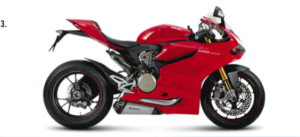

3. Ducati Panigale 1199 R (200 MPH) Here, Ducati delivers a superbike with a ferocious 1199cc engine capable of 195 horsepower and 98 pound-feet of torque. The pricey beast ($30,995) has the traditional top speed of 186 after cranking zero to 60 in 2.8 seconds, or so Ducati says. Upgrade to a track-only exhaust and the Panigale can hit 200 mph.
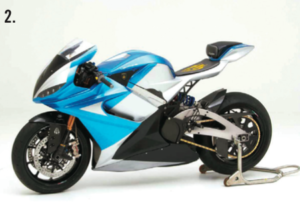

2. Lightning lS-218 (218 MPH) There were plenty of headlines when Lightning debuted an electric production bike that had already hit 218 mph at Bonneville in 2011. Both the fastest electric bike and the fastest road bike in steady production, it features 200 horse- power and 168 pound-feet of torque and can go zero to 60 in about two seconds.


1. MTT Turbine Y2K Superbike (227 MPH) It’s clear why Marine Turbine photographs and tests its bikes on airplane runways. For starters, these motorcycles run on jet turbine engines. With the option to upgrade to a monster engine capable of 420 horsepower and 500 pound-feet of torque, you can forget about zero to 60 quotes. MTT says this bike can go zero to 200 in 5.4 seconds.It’s the fastest road bike in the world.
Photos courtesy of Circuit of the Americas.

